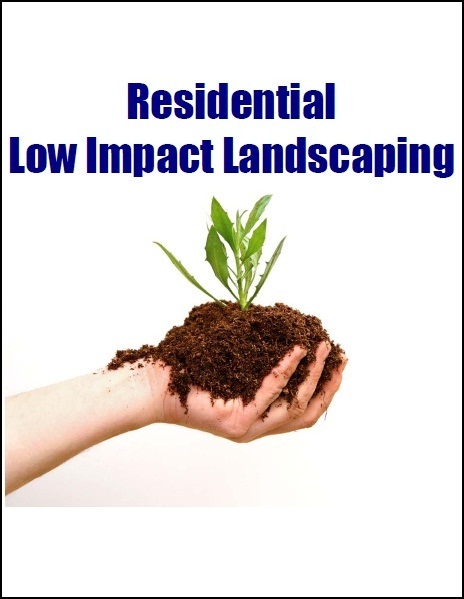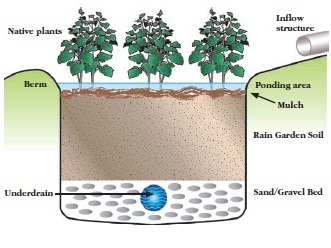Low impact development (LID) practices are increasingly being adopted to manage stormwater runoff as close to its source as possible. Rain gardens, green roofs and rain barrels are some of the most widely-known LID practices. They can help protect nearby streams and rivers by trapping rainwater and allowing it to soak into the ground over time, resulting in improvements to both the quality and quantity of stormwater runoff.
The Conservation District has been a leader in promoting well-designed low impact development techniques through publications, workshops, technical design assistance and building the actual LID practices. The following publications are written to be useful guides both for the average homeowner, the landscape professional and local jurisdictions.
Rain Garden and Low Impact Landscaping Publications
 Rain Garden Design and Construction: A Northern Virginia Homeowner's Guide is a step-by-step manual for creating home rain gardens. Rain gardens are designed to fill with water when it rains. Runoff from your home, driveway and yard can be directed to a rain garden to solve drainage issues, recharge groundwater and filter out water pollutants.
Rain Garden Design and Construction: A Northern Virginia Homeowner's Guide is a step-by-step manual for creating home rain gardens. Rain gardens are designed to fill with water when it rains. Runoff from your home, driveway and yard can be directed to a rain garden to solve drainage issues, recharge groundwater and filter out water pollutants.
The guide includes tips on materials, a worksheet to help you design and size your garden and a plant list. It is a joint publication of the Fairfax County Park Authority and the Northern Virginia Soil & Water Conservation District. Download your copy of the rain garden guide today!
 The Residential Low Impact Landscaping Handbook. This handbook introduces stormwater issues and profiles six residential low impact development practices. It also includes how to select a practice for a problem, a maintenance guide, rain garden plant list, and a catalogue of local resources. The residential LID practices profiled include:
The Residential Low Impact Landscaping Handbook. This handbook introduces stormwater issues and profiles six residential low impact development practices. It also includes how to select a practice for a problem, a maintenance guide, rain garden plant list, and a catalogue of local resources. The residential LID practices profiled include:
- Rain barrels and cisterns,
- Landscaping and reforestation,
- Dry wells, infiltration trenches, french drains and other filtering practices,
- Rain gardens,
- Pervious pavement,
- Green roofs.
 Physical Assessment of Selected Rain Gardens in Fairfax County, Virginia. Rain gardens are becoming a popular method of stormwater management both for their relative ease of installation and their environmental appeal as a low impact development practice. Yet little is known about the long-term functioning of rain gardens: several years after construction, do the rain gardens we’ve built filter the volume of stormwater for which they were designed? Are they able to cleanse that water to the anticipated degree?
Physical Assessment of Selected Rain Gardens in Fairfax County, Virginia. Rain gardens are becoming a popular method of stormwater management both for their relative ease of installation and their environmental appeal as a low impact development practice. Yet little is known about the long-term functioning of rain gardens: several years after construction, do the rain gardens we’ve built filter the volume of stormwater for which they were designed? Are they able to cleanse that water to the anticipated degree?
The Northern Virginia Soil and Water Conservation District attempted to answer these questions by surveying twenty Fairfax County rain gardens. Now completed, this research shows that while many older rain gardens function well, the functionality of others is degraded due to poor design, poor maintenance, poor initial construction or a combination of some or all of these factors. Download and read the full report (PDF).
Rain Garden & Rain Barrel Workshops
 The Conservation District, together with partner organizations, holds rain garden workshops periodically. If no workshops are currently available, try downloading a copy of Rain Garden Design and Construction (featured at the top of this page).
The Conservation District, together with partner organizations, holds rain garden workshops periodically. If no workshops are currently available, try downloading a copy of Rain Garden Design and Construction (featured at the top of this page).
Rain barrels are another low impact development practice homeowners are adopting across Northern Virginia. Rain barrels are put under or attached to your home's downspouts, collecting up to 20,000 gallons a year on an average roof! The Northern Virginia Rain Barrel Program makes rain barrels available to homeowners at a low cost. Workshops are held from spring through mid-fall. Learn more or register for a rain barrel workshop.
Low Impact Development Demonstration Project
The Conservation District, in partnership with Fairfax County and other key organizations, piloted a groundbreaking LID demonstration project in the Falls Hill and Poplar Heights neighborhoods in 2008 and 2009.
Green Roofs
Are you interested in a green roof for your home or business, but don't know where or how to see one? A beautiful green roof at the Fairfax County Government Center is easy to access and available for anyone to tour during daylight hours! The vegetated roof is located on the upper level of the Herrity Building parking garage. To access the site, enter the garage behind the Herrity building. Navigate to the top deck of the parking garage; you can park your car in any of the parking spaces adjacent to the rooftop garden. The 5,000 sq. ft Herrity green roof is a demonstration project, designed to showcase the beauty and variety of green roofs as well as the numerous environmental benefits vegetated rooftops provide. See the address and directions to the Herrity Building.
 A modest condominium community in Fairfax County is greening up. Yes, that’s up... on the roof. Yorktowne Square has installed a vegetated roofing system, demonstrating an innovative way of managing stormwater runoff. Instead of increasing impervious surface like a conventional roof, a “green” roof can absorb up to 70% of stormwater, which is similar to the absorption rate of a healthy, aerated lawn.
A modest condominium community in Fairfax County is greening up. Yes, that’s up... on the roof. Yorktowne Square has installed a vegetated roofing system, demonstrating an innovative way of managing stormwater runoff. Instead of increasing impervious surface like a conventional roof, a “green” roof can absorb up to 70% of stormwater, which is similar to the absorption rate of a healthy, aerated lawn.

